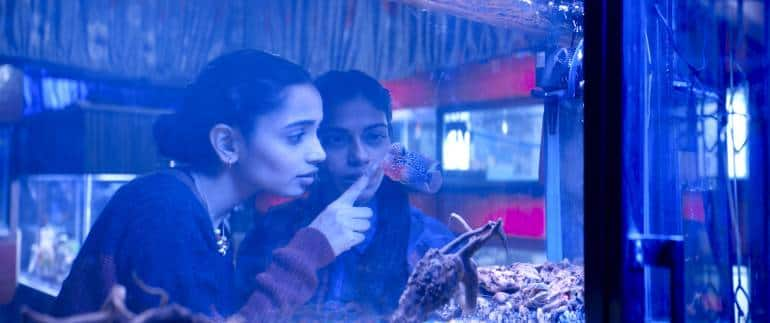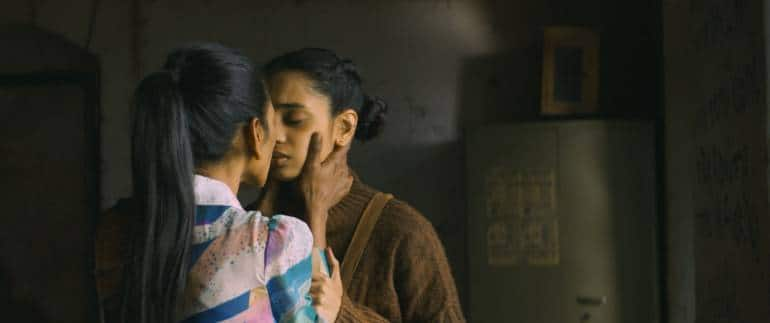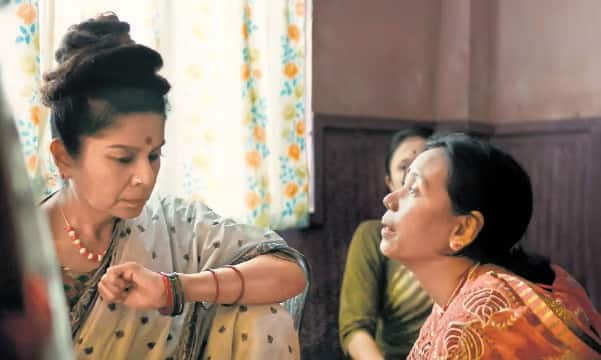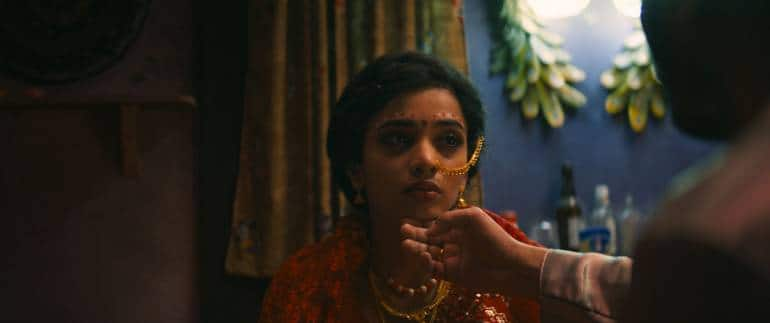



Omara Shetty, one of the leads of The Shameless, who walked the Cannes red carpet in a Louis Vuitton dress — deservedly so, for she was there with a film premiere — recalls a funny memory from the shoot days of her intense film, “at times, even doing eight-nine scenes in a day, since we were short on time.” Besides, the story itself is intense.
While her co-actors were shooting a scene by the riverbank in Nepal, Omara chose to make use of her free time to sky-gaze. She got atop a bus, fixed her gaze up and lost herself in that act. It was a “just-like-that urge” to escape to nowhere that she channels best through her character Devika in Bulgarian filmmaker Konstantin Bojanov’s The Shameless, which premiered in Un Certain Regard at the just-concluded 77th Cannes Film Festival, alongside British Indian Sandhya Suri’s Santosh, starring Shahana Goswami. The Shameless won her co-lead Anasuya Sengupta the Best Performance award, the first Indian actor to win the award at Cannes.
 (From left) Omara Shetty, Konstantin Bojanov and Anasuya Sengupta at the 77th Cannes Film Festival. (Photo: Instagram/Getty Images)
(From left) Omara Shetty, Konstantin Bojanov and Anasuya Sengupta at the 77th Cannes Film Festival. (Photo: Instagram/Getty Images)
Steered by a host of power-packed actors, including Mita Vashisht, Auroshika Dey, Tanmay Dhanania and Rohit Kokate, The Shameless is helmed by Omara and Anasuya Sengupta as two accidental lovers, Devika and Renuka, respectively, both condemned to a living hell of sex work in a set that was built from scratch in Nepal, because production costs in India was too high. If Renuka has not breathed freely in a world outside of brothels, Devika hasn’t seen the sunlight outside her inferno-like home, which nudges at an era of devadasi tradition of prostitution. While both are doomed to the same fate and sex work profession, there is power dynamics, the devadasis are not looked at derogatorily because it is religion-approved.
Bojanov’s film, inspired by real people and events, is very telling and quite unsettling in its depiction of the vicious cyclicality of fate these women and their lot are destined for. Into this fold he weaves in themes of patriarchy, dysfunctional family, unsafety of homes, generational trauma, consumerism that drives prostitution, and mob culture.
Few words explain the hell-hole better than songs, whether the Enrique Iglesias’ “you can run, you can hide, but you can’t escape” or Hotel California’s “you can check out any time you like, but you can never leave” — if Anasuya’s Nadira-turned-Renuka is on the run, trying to avenge herself and escape, and ends up bumping into Omara’s Devika, who’s hiding herself from herself, so as to escape the destiny her sister, mother and grandmother have been doomed to, can they rewrite their own destiny?
Omara is a Thane girl who traces her roots to Kinnigoli and Mangalore. She studied journalism from SM Shetty College, Mumbai, and wanted to become a writer. She did write a rap song that she sings in the film, for which Konstantin pushed her to listen to Nepalese rapper Dmitri and create something which is not perfect and reflects Devika’s helplessness and resolve. “I understood that Devika was not supposed to fully embrace her life at this point, hence, whatever she wrote was an influence of sorts, whatever she saw on screen, on TV, that it’s not supposed to be perfect,” says Omara, who has learnt Bharatanatyam and Kalaripayattu, worked briefly as a journalist, did “immersive plays” with Rangaai Theatre Company group in Mumbai’s Andheri and studied at Bangalore’s Attakkalari Centre for Movement Arts. She’s worked in a Singaporean episodic web-series, the DBS Sparks, and, later, landed a bit role in the Katrina Kaif-starrer Phone Bhoot (2002). “Phone Bhoot happened at a time when I did not have money and because of COVID, people weren’t getting work, so, I took it up for money. But the invaluable learning there helped me while working in The Shameless,” she says.
 A still from 'The Shameless'. (Image courtesy Urban Factory)
A still from 'The Shameless'. (Image courtesy Urban Factory)
Omara was onboarded The Shameless via a casting agency run by Paragg Mehta and after several auditions. Anasuya’s casting, on the other hand, was peculiarly unusual.
Anasuya’s feisty, unchanging Renuka is a stark contrast to Omara’s timid, diffident, vulnerable, resilient Devika, who’s seeking change. The two are chalk and cheese but, perhaps, that’s how opposites attract. There is also a savior complex in Renuka, who seeks to rescue Devika. There are delicate, intimate moments between the two, there is kissing but no disrobing or sex shown, it is unnecessary to Renuka and Devika’s love story. In their world, which is all about the baser instincts, their love for each other surfaces as pure and sublime even therapeutic.
 A still from 'The Shameless'. (Image courtesy Urban Factory)
A still from 'The Shameless'. (Image courtesy Urban Factory)
“Shameless is basically a label. The moment when someone doesn’t act or behave the way they are supposed to, or as a society has told you to, you are shameless. If having your own choice and wanting to be what you want to be makes me shameless, so be it. Shameless is how I see Renuka, as the anti-hero protagonist. While Devika is going through a transformation, and coming to realise herself and becoming the shameless. The two kind of leads: One who is not going to change, and the other one who is going through a change. The very first time I met Anasuya, it just worked so well. We instantly hit it off. Giving each other space helped in bringing in our chemistry. A combination of space, communication and clarity. We talked about our scenes and once the shoot began we went with the flow. In the intimate scenes, we had an intimacy coordinator from Nepal, the director was in another room, and there were limited people in the room, which actually is commendable. You don’t have too many eyes on you. It becomes more authentic,” says Omara.
 Mita Vashisht (left) in a still from 'The Shameless'. (Image courtesy Urban Factory)
Mita Vashisht (left) in a still from 'The Shameless'. (Image courtesy Urban Factory)
The veteran Mita Vashisht plays Devika’s grandmother in the film and Auroshikha Dey plays her “tyrant” mother. “Auroshikha is a wonderful actor, and we became super close. It was my first time as a lead on a film set, and many times, I would not voice my opinions straight away, Auroshikha would always ask me if I were okay with a scene, how I was feeling about my character, she instilled confidence in me. And Mita ma’am is a force, she’s super fun. She guided me about breath work. This is something that I also studied at Adishakti Theatre (in Pondicherry), which helps immensely, that once you have control over your breath, emoting becomes easier and then you’re not straining too much. Mita ma’am tried telling me that you don’t have to suffer to give a great performance.”
 Omara Shetty in a still from 'The Shameless'. (Image courtesy Urban Factory)
Omara Shetty in a still from 'The Shameless'. (Image courtesy Urban Factory)
Almost like transitioning from a caterpillar to a butterfly, in Devika, Omara brings out a fine balance of vulnerability, helplessness, resilience and resolve. There are many open-ended scenes involving Devika which Konstantin refuses to explain or give a backstory, especially the nightmare/dream sequences, of a body falling off the bridge into a river, wooden chairs piled in a stack, burning embers in a room, blood spreading on a bedsheet, her bloodied hands, her inability to light a matchstick every time she’s shaken — all these sequences work at a symbolic level.
Here is a traumatised young woman who hides herself in layers of clothing and tightly tied hair so as to escape the men who come seeking her in bed. Her “market rates are high”. Perhaps, she also sees herself as a man. Her creative escape is writing rap songs.
 A still from 'The Shameless'. (Photo courtesy Urban Factory)
A still from 'The Shameless'. (Photo courtesy Urban Factory)
“There’s a lot of her (her character Devika) in me, definitely,” says Omara, adding, “Konstantin told me, ‘you don’t have to cry’. Devika’s emotions cannot be too loud, it has to be restrained and contained. Devika hides, even when it comes to her clothing, she hides in the layers. Her opinions don’t matter in the household. And she doesn’t really have friends. And that’s where her writing ability kicks in. So that could be one of the reasons why she writes, or she has a journal of sorts. She might not be a good rapper, but she definitely is someone who could write a good rap. Being someone who’s been trained in Bharatanatyam since I was five years old, for me, I had a little difficulty with restraining because in Bharatanatyam, we are often told to use our eyes to express. This is one of the most vital things that we have been taught. The other method that I used was journaling to bring clarity into what the thought process of Devika is at that particular moment. A graph method. I come from theatre, and this was the first time I was actually doing a lead role, and it brings a lot of responsibility. So, the graph method really helped in charting out the next day’s scenes: what is the range that you’re supposed to achieve, where does your character lie emotionally, what is the growth of the character at that point in the story, etc. And there was room for improvisation.”
 A still from 'The Shameless'. (Image courtesy Urban Factory)
A still from 'The Shameless'. (Image courtesy Urban Factory)
In the film, the trajectory of growth of her character Devika is directly proportional to the transformation, among other things, her hair goes through. From a tightly tied-up plaits as she hides from the world to them coming loose as her love blossoms to her eventually chopping it all off as an act of resistance. “I had long hair and I had to cut it. So, every time I would look at myself in the mirror, early in the morning, it’s not who you were before. Just the strands of hair, it took time for me to accept it and took me a great while to let go of Devika thereafter,” says Omara.
Discover the latest Business News, Sensex, and Nifty updates. Obtain Personal Finance insights, tax queries, and expert opinions on Moneycontrol or download the Moneycontrol App to stay updated!
Find the best of Al News in one place, specially curated for you every weekend.
Stay on top of the latest tech trends and biggest startup news.